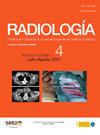Quistogastroenterostomía percutánea para el tratamiento de las colecciones pancreáticas
IF 1.1
Q3 RADIOLOGY, NUCLEAR MEDICINE & MEDICAL IMAGING
引用次数: 0
Abstract
Objective
Acute pancreatitis (AP) is an inflammatory condition associated with a potential torpid evolution comprising multiple organ failure, pancreatic necrosis, infected collections and high mortality. Current management tends use the step-up approach, with endoscopic collection drainage, followed by percutaneous drainage by an interventional radiologist and video-assisted necrosectomy. We present our experience with a new percutaneous technique of establishing an anastomosis of the pancreatic collection with the closest loop, stomach, duodenum or jejunum that uses balloon dilation and drainage in cases of infection.
Material and methods
Between 2009 and 2023 we have applied this technique in 30 patients, aged between 32 and 82 years (mean: 67 years), 14 with pseudocysts (infected in six cases) and 16 with encapsulated necrosis (all infected). We use dilation balloons of different calibre, to establish the anastomosis between the digestive loop and the collection, as well as different drainages.
Results
The intervention had a primary technical success of 93%. In two patients the cystogastrostomy had to be repeated due to initial technical failure; in both cases a good result was achieved. One patient had a severe postintervention haemorrhage (3%) that required embolisation. Length of follow-up has ranged from between three months and 10 years (mean: 4 years), with no recurrence of the anastomosed collection or cutaneous fistula observed in any case.
Conclusion
Percutaneous cystogastrostomy is a technique that allows infected collections to be resolved and pancreatic fistulas to be avoided, with few complications, which can be resolved by interventional vascular radiologists.
治疗胰腺积液的经皮糜烂性胃肠造口术
目的:急性胰腺炎(AP)是一种与潜在的迟钝演变相关的炎症性疾病,包括多器官衰竭、胰腺坏死、集合感染和高死亡率。目前的治疗倾向于采用逐步的方法,内镜下收集引流,然后由介入放射科医生进行经皮引流和视频辅助的坏死切开术。我们介绍了一种新的经皮技术,在感染的情况下,使用球囊扩张和引流的方法,将胰腺集合与最近的袢、胃、十二指肠或空肠建立吻合。材料和方法在2009年至2023年间,我们应用该技术治疗了30例患者,年龄在32岁至82岁之间(平均67岁),其中14例为假性囊肿(6例感染),16例为囊性坏死(均感染)。我们使用不同口径的扩张气球,建立消化道与集合之间的吻合,以及不同的引流。结果干预的初步技术成功率为93%。2例患者由于最初的技术故障不得不重复进行囊胃造口术;在这两种情况下都取得了良好的结果。1例患者有严重的干预后出血(3%),需要栓塞。随访时间从3个月到10年(平均4年)不等,在任何情况下均未观察到吻合集或皮瘘复发。结论经皮囊胃造口术是一种治疗胰腺感染、避免胰腺瘘的技术,并发症少,可由介入血管放射科医师解决。
本文章由计算机程序翻译,如有差异,请以英文原文为准。
求助全文
约1分钟内获得全文
求助全文
来源期刊

RADIOLOGIA
RADIOLOGY, NUCLEAR MEDICINE & MEDICAL IMAGING-
CiteScore
1.60
自引率
7.70%
发文量
105
审稿时长
52 days
期刊介绍:
La mejor revista para conocer de primera mano los originales más relevantes en la especialidad y las revisiones, casos y notas clínicas de mayor interés profesional. Además es la Publicación Oficial de la Sociedad Española de Radiología Médica.
 求助内容:
求助内容: 应助结果提醒方式:
应助结果提醒方式:


